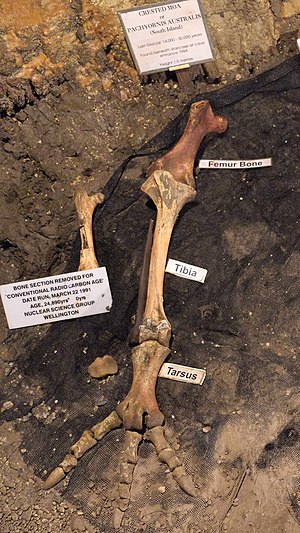Crested moa
The Crested moa (Pachyornis australis) was a type of moa. It only lived in New Zealand. It was a bird that could not fly.[3]
| Crested moa | |
|---|---|

| |
| Pachyornis australis bones in Ngarua Caves | |
| Conservation status | |
| Scientific classification | |
| Unrecognized taxon (fix): | Pachyornis |
| Species: | Template:Taxonomy/PachyornisP. australis
|
| Binomial name | |
| Pachyornis australis | |
| Synonyms | |
|
List
| |
Description
The crested moa was small. It weighed around 75 kg (165 lb). It crested moa was smaller than the heavy-footed moa.
Distribution and Habitat
The crested moa only lived in the South Island of New Zealand. It lived in high up in sub-alpine forests.[4][5]
Diet
The crested moa is a herbivore. It eats plants. The only predator it had was the Haast's eagle.[6][7]
Extinction
It is thought that the crested moa didn't go extinct because of humans. This is because the crested moa lived in places that were hard to get by humans. It Is thought that animals like cats that humans brought to New Zealand caused the crested moa to go extinct.[4]
References
- ↑ Oliver 1949, pp. 70–74
- ↑ Checklist Committee Ornithological Society of New Zealand (2010). "Checklist-of-Birds of New Zealand, Norfolk and Macquarie Islands and the Ross Dependency Antarctica" (PDF). Te Papa Press. Retrieved 4 January 2016.
- ↑ Grzimek, Bernhard (2003–2004). Grzimek's animal life encyclopedia. Neil Schlager, Donna Olendorf, American Zoo and Aquarium Association (2nd ed.). Detroit: Gale. ISBN 0-7876-5362-4. OCLC 49260053.
- ↑ 4.0 4.1 Berentson, Quinn (2012). Moa : the life and death of New Zealand's legendary bird. Nelson, N.Z.: Craig Potton. ISBN 978-1-877517-84-6. OCLC 819110163.
- ↑ Worthy, T.H. (1990). "An analysis of the distribution and relative abundance of moa species (Aves: Dinornithiformes)". New Zealand Journal of Zoology. 17 (2): 213–241. doi:10.1080/03014223.1990.10422598. ISSN 0301-4223.
- ↑ Cooper, Alan; Atkinson, I.A.E.; Lee, William G.; Worthy, T.H. (1993). "Evolution of the moa and their effect on the New Zealand flora". Trends in Ecology & Evolution. 8 (12): 433–437. doi:10.1016/0169-5347(93)90005-A. PMID 21236223.
- ↑ Rawlence, Nj; Cooper, A (2013). "Youngest reported radiocarbon age of a moa (Aves: Dinornithiformes) dated from a natural site in New Zealand". Journal of the Royal Society of New Zealand. 43 (2): 100–107. doi:10.1080/03036758.2012.658817. ISSN 0303-6758. S2CID 140198673.